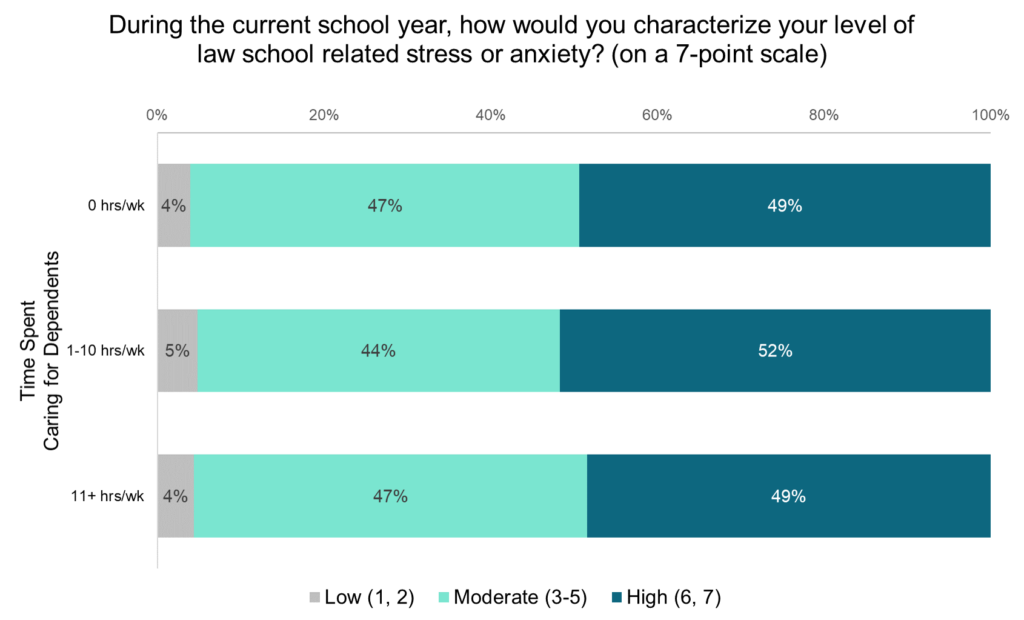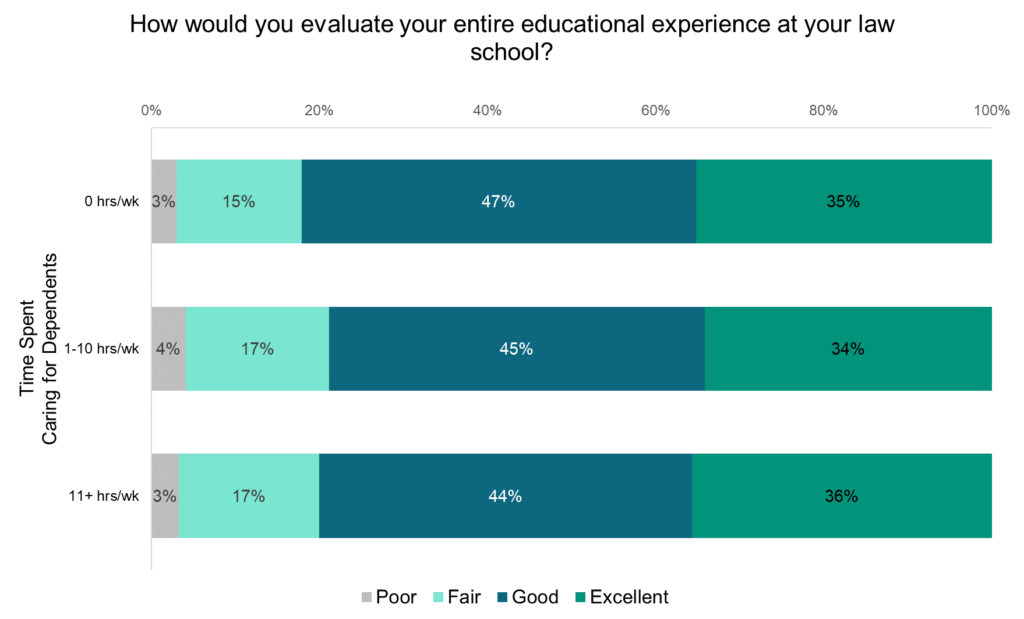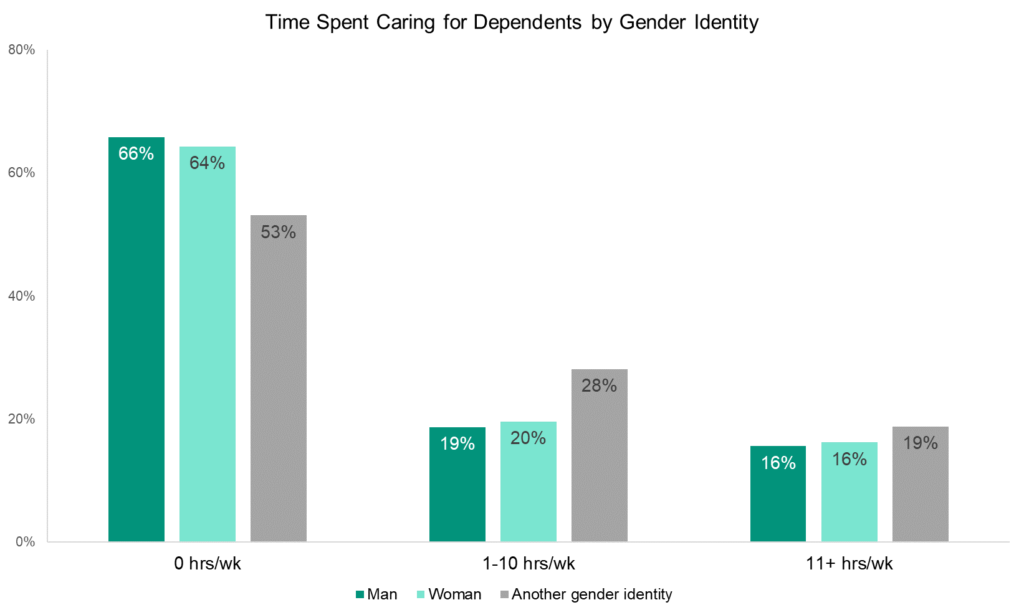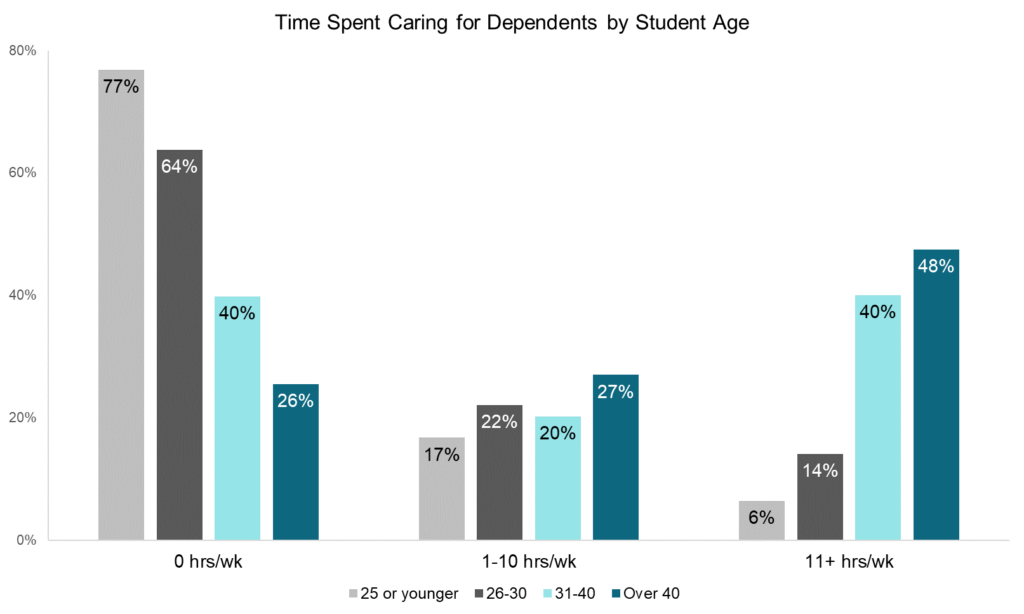Focus on First-Generation Students, Part 2
In our last post, we shared some of the demographic characteristics of first-gen law students, which we define as law students who do not have at least one parent with a bachelor’s degree. In this post, we will dig deeper into the first-gen law student experience and how it differs from the experiences of non-first-gen law students.
Time Usage
LSSSE asks students to estimate the average number of hours they spend each week engaging in activities that are directly and indirectly related to the educational experience. Time usage is important because it reflects students’ academic engagement and overall priorities. First-gen students are more likely to attend law school part-time, which suggests that they have complicated schedules with competing demands, rather than a sole focus on law school. LSSSE data show that high percentages of first-gen students have familial obligations as caretakers for dependents living in their household. Forty-four percent (44%) of first-gen students spend time caring for dependents, compared to 33% of non-first-gen students.

First-gen students are just as engaged as their non-first-gen peers in academic pursuits outside of class, despite the fact that they have more responsibilities competing for their time. First-gen students work with students and faculty on group projects at equal or greater levels relative to non-first-gen students. Roughly equal percentages of first-gen students (19%) and non-first-gen students (18%) report that they frequently work with faculty members on activities other than coursework (including committees, orientation, student life activities, etc.). Likewise, 33% of first-gen (and 31% of non-first-gen) students frequently work with classmates outside of class to prepare assignments. The diligence of first-gen students is particularly impressive given their personal obligations. One third (33%) of first-gen students always come to class fully prepared despite their family duties and work schedules, the same percentage as non-first-gen students (who tend to work less and have fewer familial obligations).
Satisfaction
First-gen students, like law students overall, are overwhelmingly satisfied with their law school experience. Seventy-four percent (74%) of first-gen students evaluate the educational experience at their law school as “good” or “excellent,” similar to non-first-gen students (78%). Furthermore, 77% of first-gen (and 79% of non-first-gen) students report they would choose to attend the same law school again, with the benefit of hindsight. These trends are particularly noteworthy given the increased financial risks and other sacrifices made by first-gen students to attend law school.

First-gen students face unique challenges and responsibilities as they navigate legal education. Law schools should take the findings from this Annual Report, as well as their own school-specific LSSSE data, to craft targeted programs to support first-gen students. Better supporting them personally will free up time and resources for first-gen students to devote to not only academics, but other co-curricular pursuits so they are optimally placed to thrive as they enter the legal profession.
Time Spent Caring for Others, Part 2
In our last post, we examined the differences in time spent caring for dependents among law students by age, gender, and enrollment status (part-time or full-time). In this post, we look at the stress and satisfaction levels of students with different levels of caretaking duties. Most law students report moderate to high levels of law school related stress and anxiety (3 or higher on a 7-point scale). Interestingly, there are virtually no differences in law school related stress levels among students based on the amount of time they spend caring for dependents. Students at all levels of caretaking responsibility are all equally stressed during law school, with around 50% having high levels and around 45% having moderate levels.

Law students with no, low, or high levels of time spent caring for dependents also report similar levels of satisfaction with the law school experience, with slightly more than a third saying their experience has been “excellent” and slightly less than half rating their experience as “good.”

However, students with varying levels of caretaking responsibilities do diverge in how they allocate their time among law school activities, work, and leisure. Nearly half (49%) of students with caretaking duties spend more than five hours per week commuting to class while only 37% of students without caretaking duties report the same. Students without dependents tend to spend more time on leisure activities such as socializing and exercising whereas students with dependents are more likely to work for pay and have longer commutes to class. This suggests that caretaking students meet the needs of their dependents at the expense of time that might otherwise be spent on self-care activities. This trade-off is similar to the findings of the LSSSE 2019 Annual Results, which show that women are performing well in law school but with higher costs to their physical and mental health relative to their male classmates. Non-caretakers are slightly more likely to spend at least five hours per week participating in law school activities while caretakers are somewhat more likely to engage in legal pro bono work not required for class and to participate in community activities. So when caretaking students have the ability to engage in extracurricular activities, they are likely to choose different activities than their non-caretaking classmates.

Clearly, the way students spend their time varies depending on whether they spend time caring for others during the week, even though both groups are remarkably similar in stress levels and overall satisfaction. This implies that students who differ in caretaking duties may adapt by taking advantage of different resources and strategies in order to make the most of their law school experience. Students who have greater caretaking duties are also more invested in other non-campus-related activities—including work, community organizations, and pro bono services. Though they spend less time socializing, they remain almost equally invested in participating in law school activities overall.
Time Spent Caring for Others, Part 1
Law students with support networks are more likely to be successful in their studies, but students who are interdependent with others may also bear substantial caretaking duties. In the analysis of how students use their time, LSSSE asks about how many hours per week respondents provide care for dependents living in their household (parents, children, spouse, etc.). We decided to dig into the data to see which students are most likely to spend time caring for others and how caretaking duties interact with measures of student stress and satisfaction.
Demographics of Caretaking
Among law students, men and women are equally likely to report spending some amount of time each week caring for dependents who live with them. Thirty-five percent of men and 36% of women spend at least one hour per week taking care of dependents. Students of other gender identities spend somewhat more time on caretaking duties, with almost half (47%) spending at least an hour per week.

As law students get older, they tend to spend more time on caretaking tasks. About 77% of students 25 or younger spend no time at all caring for dependents during the week, but only 26% of students over 40 can report the same. In fact, about half of students over 40 spend eleven or more hours per week taking care of dependents. About 40% of students in their thirties have similarly intense caretaking roles, but that figure drops dramatically for students under 30.

Part-time students are more likely than full-time students to spend some time each week caring for dependents. Fifty-six percent of part-time students report caring for dependents compared to 32% of full-time students. One-third of part-timers spend eleven or more hours per week caring for dependents while just 13% of full-timers report the same.

Overall, the LSSSE data show that there are variations in the time students spend caring for children, parents, and others. Older students and part-time students are more likely to spend time caring for dependents, relative to their younger and full-time counterparts. Interestingly, men and women are about equally likely to engage in caretaking duties. Next week, we will explore how caretaking responsibilities interact with law students’ stress levels and their overall satisfaction with the law school experience.



